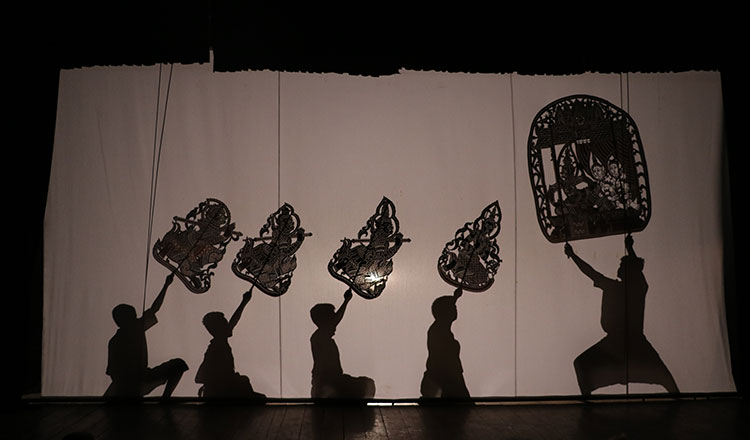ART: Leather carving and shadow puppetry – A dying art, a dying culture?
.
Leather carving and shadow puppetry have been part of Cambodian culture for thousands of years. Performances used to transpire across the Kingdom regularly, with some performers even going abroad to showcase the art. But has the art remained as fervent as it was decades ago? Shadow puppet master Mann Kosal shares his perspective with Agnes Alpuerto and Say Tola.
.
The orange and blue corrugated sheet serving as main gate may not really be something you’d expect of a performance art hall. Except for the signage on the side that bears the name of Sovanna Phum Theatre, there is actually no hint that inside the small compound is an art that has been preserved earnestly by a man who dedicated most of his life to shadow puppetry.
But there they were – the master, his leather-carved puppets and the puppeteers – proudly presenting the product of their decades of hard work.
.
ADS by Cloud 9:
.
– SPACE RESERVE FOR YOUR ADVERTISEMENT –
.
.
Giant puppets held between two tall bamboo sticks came alive as they moved gracefully on the white backdrop. Their silhouettes created a dramatic effect, their animators in synchronised gestures. A group of traditional musicians on the left added to the thrill, and the narrator completed the whole ensemble.
They were performing a classic Khmer folktale.
But while intense passion and utter creativity were evident up on stage, the audience area had only 10 people. The theater was supposed to accommodate 80.
“Most of those who came were foreigners. Before, we could fill up all the seats. But perhaps they (locals) don’t think this is a good show,” said Mann Kosal, a shadow puppet master and the founder of Sovanna Phum Arts Association.
It was in 1988 when Mann Kosal’s interest in leather carving was ignited. He watched a German-produced film about Cambodia’s shadow puppetry art and started to try to make some himself. But Mann Kosal didn’t have a teacher to teach him leather carving. “So I had to learn by myself. It was really taught in school.”
.
ADS by Cloud 9:
.
– SPACE RESERVE FOR YOUR ADVERTISEMENT –
.
.
In 1993, he decided to create Sovanna Phum Arts Association to share the skill he has acquired over the years and to gather locals who upheld the same passion as him. His group performed more than twice weekly, depending on the demand. People paid $5 for a ticket to Sovanna Phum’s shows, and they were guaranteed of a sbek thom show like no other.
Mann Kosal made the leather carvings and face masks by himself – from buying the cow skin at the slaughterhouses, to cleaning the material, drawing the design, cutting out the intricate shapes, colouring the leather puppets to creating their wood support. He wasn’t called shadow puppet master for no reason.

The art organisation also had several students in the past. Mann Kosal personally taught over a hundred students in the past years. They learned the basics of large leather carving and shadow puppetry.
“This kind of art performance is not part of the curriculum. So young people who want to learn this craft come to me and I do some trainings at night. They go to school in the afternoon, they come here in the evening.”
But even with the interest Cambodians had shown in the past for the art of shadow puppetry, Mann Kosal admitted that they had eventually stopped coming into his theater when they got married, graduated or found other jobs.
. .
.
ADS by Cloud 9:
.
– SPACE RESERVE FOR YOUR ADVERTISEMENT –
.
.
As his students numbered fewer as the years went by, his audience also eventually declined. Mann Kosal had to increase his ticket price to $10 to pay for the land rent, performers’ wages, puppet repairs and equipment. But even with such amount, the shadow puppet master could barely afford his personal medicine.
Having run the theater for 25 years now, Mann Kosal surely knows what has happened to the art he has fervently protected and preserved.
“Cambodians have no interest in this. They don’t think shadow puppetry is a good show and they don’t think this can benefit them,” he said, shaking his head. “But I can’t really blame them. This is how the society has shaped them.”
It was in 2005 when sbek thom was listed as UNESCO’s Intangible Cultural Heritage. The feat was well-celebrated in the kingdom, with the Ministry of Culture and Fine Arts expressing its full hopes to put forth the art into pedestal, like how it should be. But when the excitement and joy died down, sbek thom came back to being a mere name of an ancient art.
Mann Kosal also had his hopes up after UNESCO’s declaration. But he also readied himself to accept that the interest in large puppet carving and performance would not last for too long.
“And my prediction was right, always right,” he quipped.
He further noted, “shadow puppetry is not the only Cambodian art that’s slowly dying. Even the Village Festival, which is supposed to be grand, is no longer as relevant for young people. Technology and modernity – these two have influenced Cambodians so much. They changed the rules, even for the monks. Cambodians no longer have the identity we used to carry with us.”
“When I went to foreign countries to showcase shadow puppetry, I couldn’t identify Khmers because they dress up and act like everyone else. I could easily pinpoint Japanese, Indonesians, Filipino and Malaysians from the crowd because they have their distinct look and identity. But Cambodians? They just blend in now, like they’re not proud of who they are.”
“It’s a dying art. It’s a dying culture.”



























